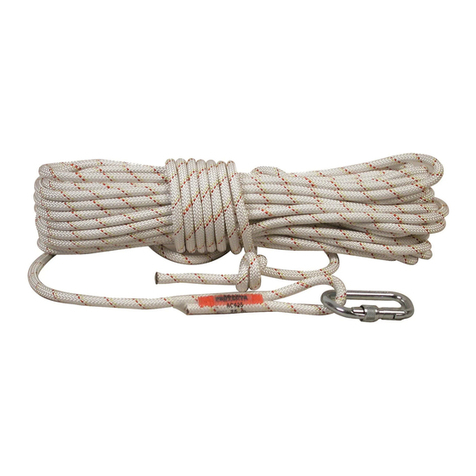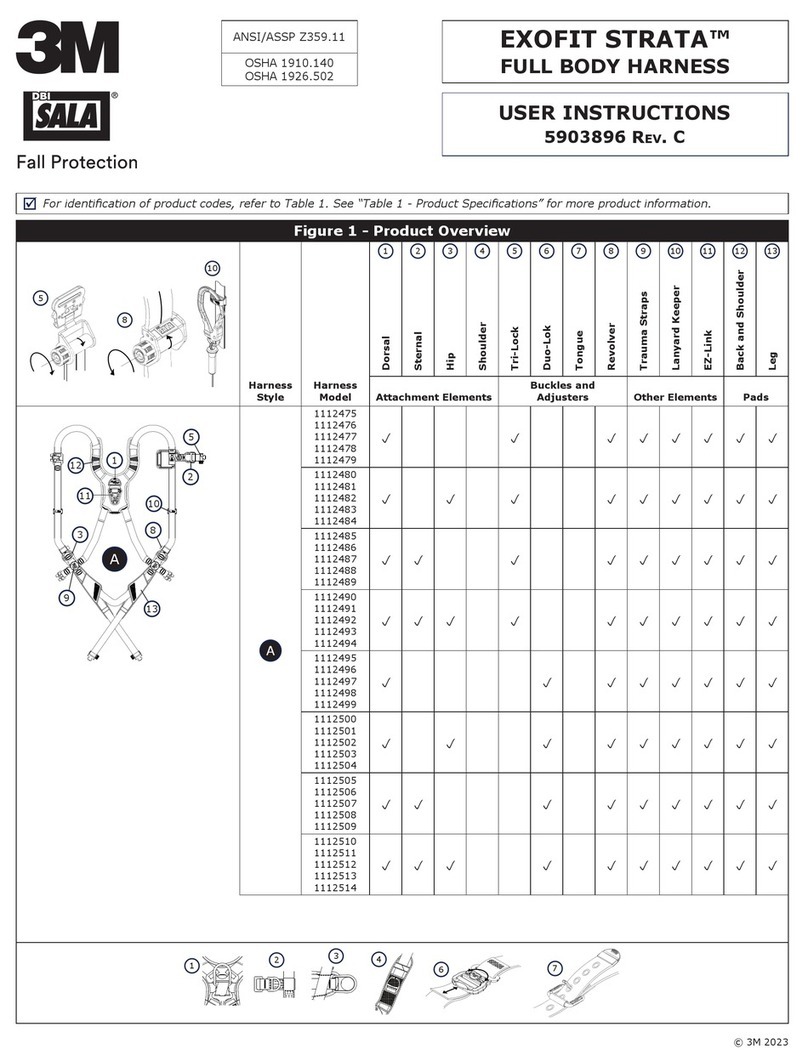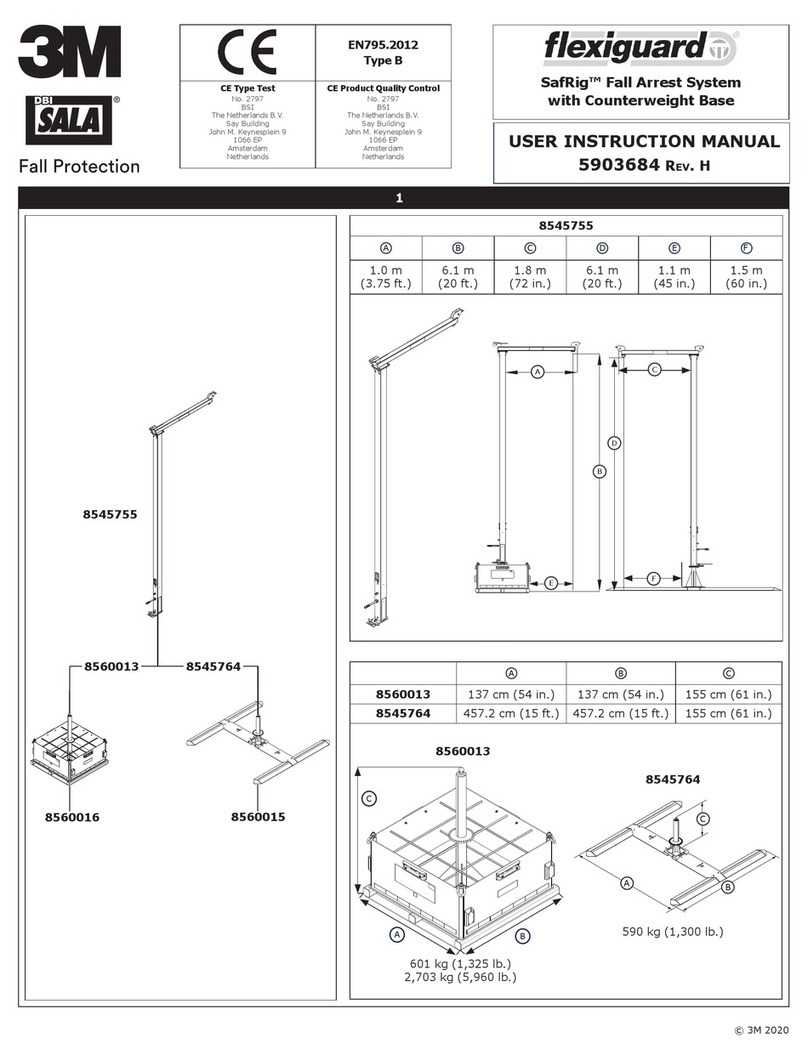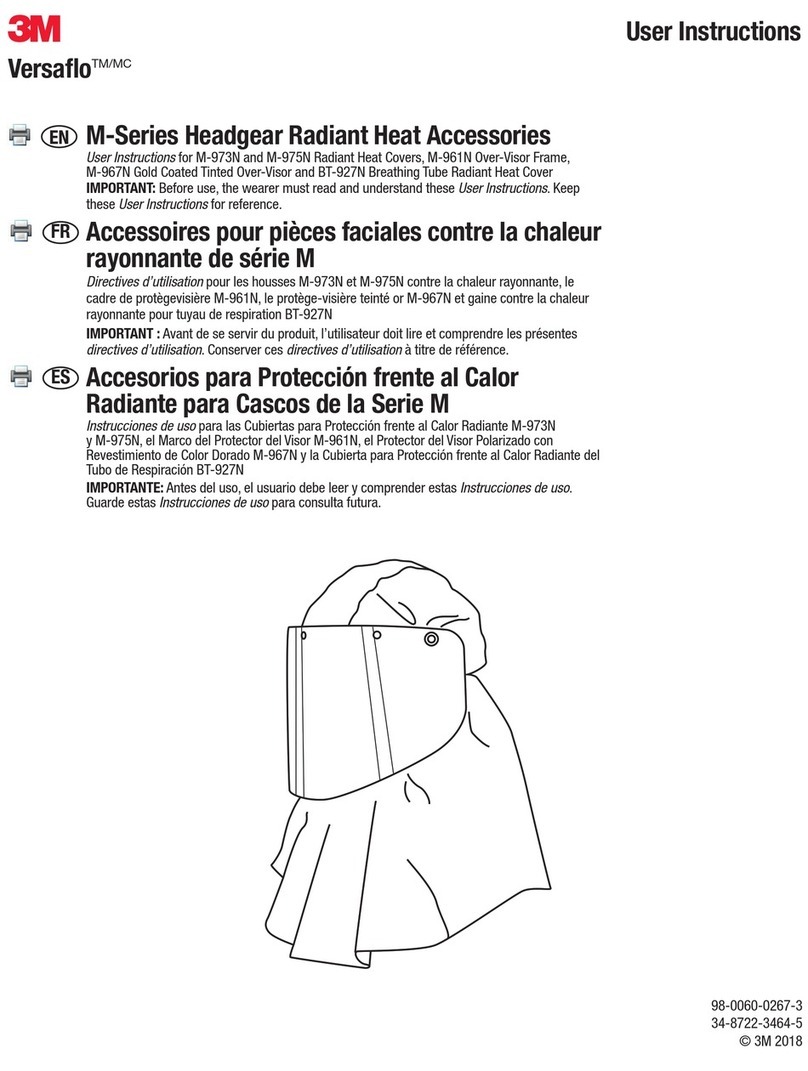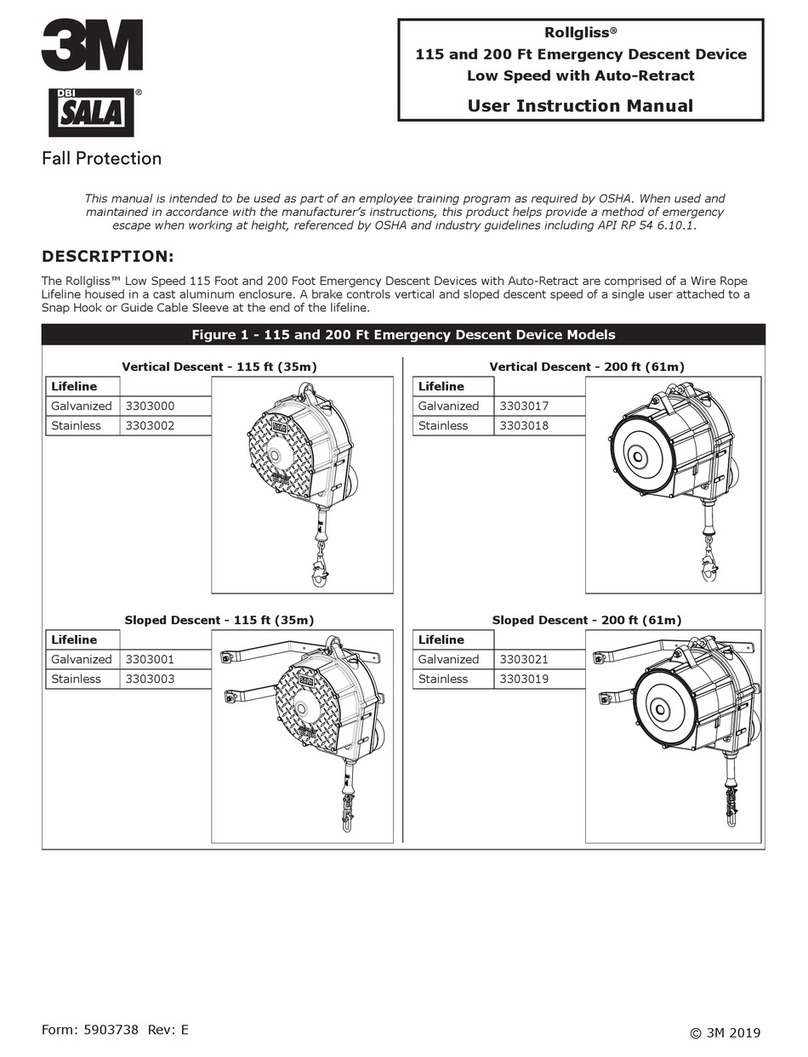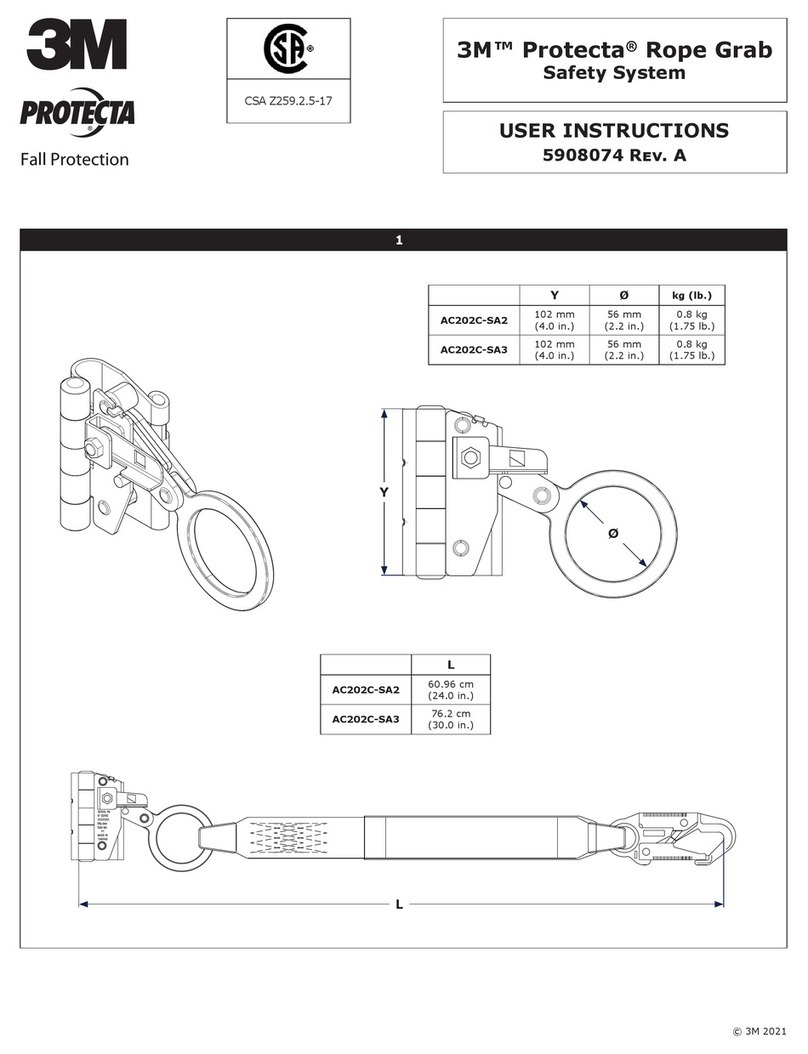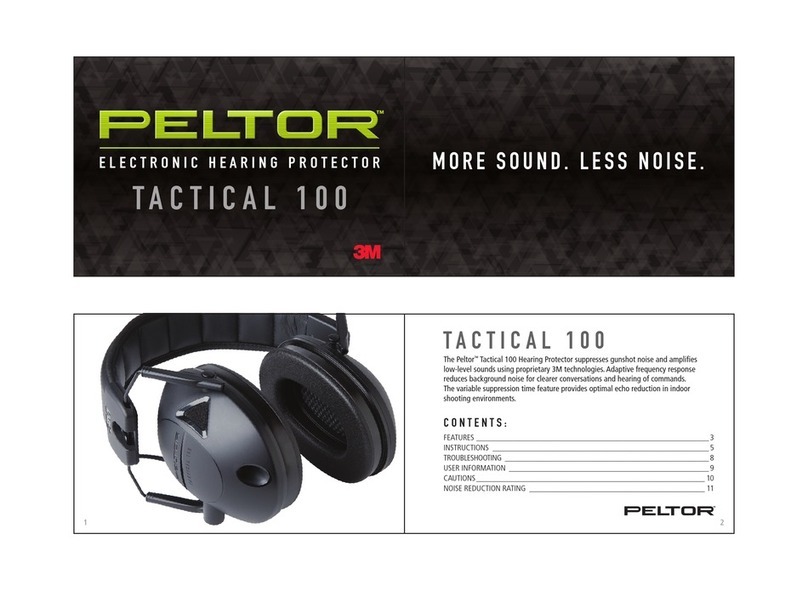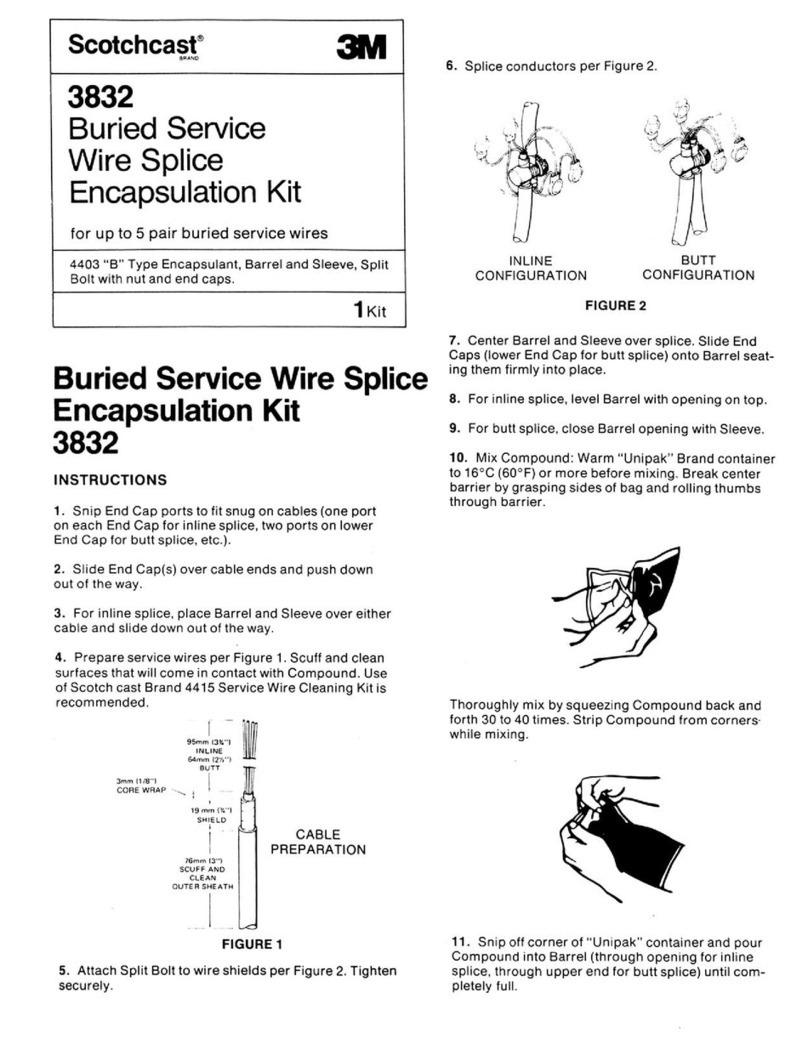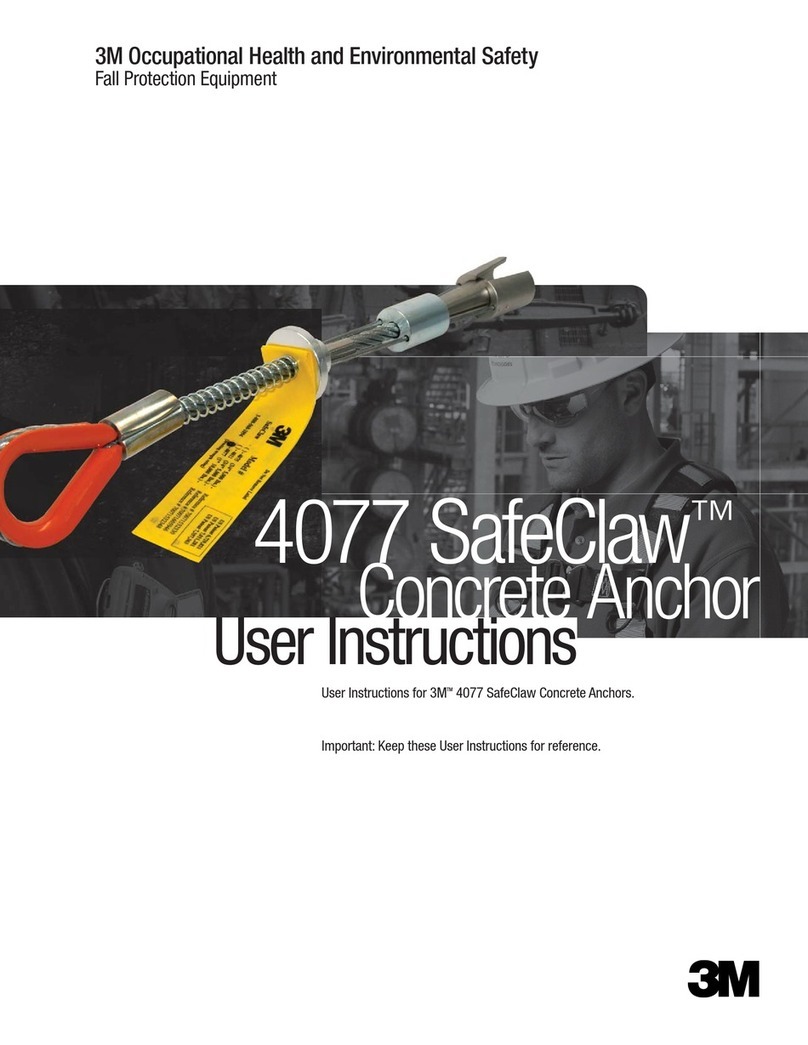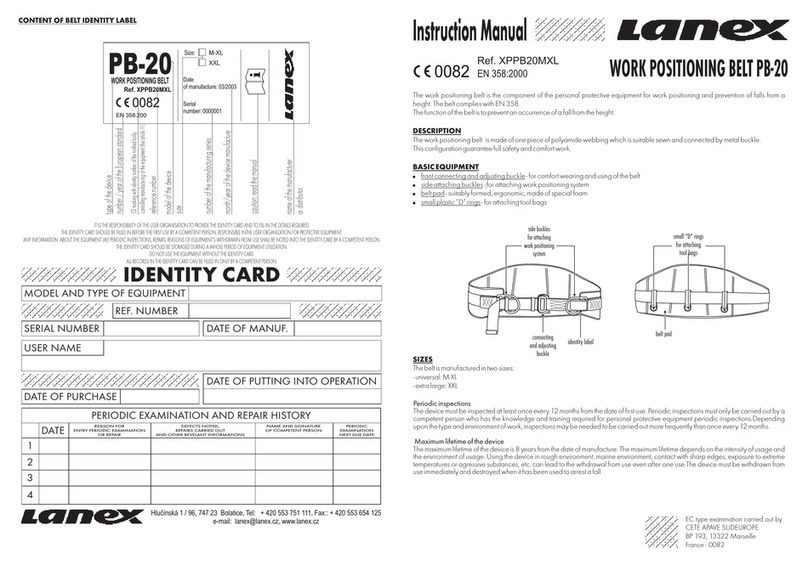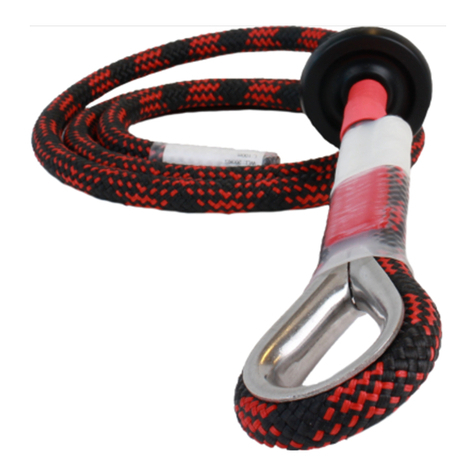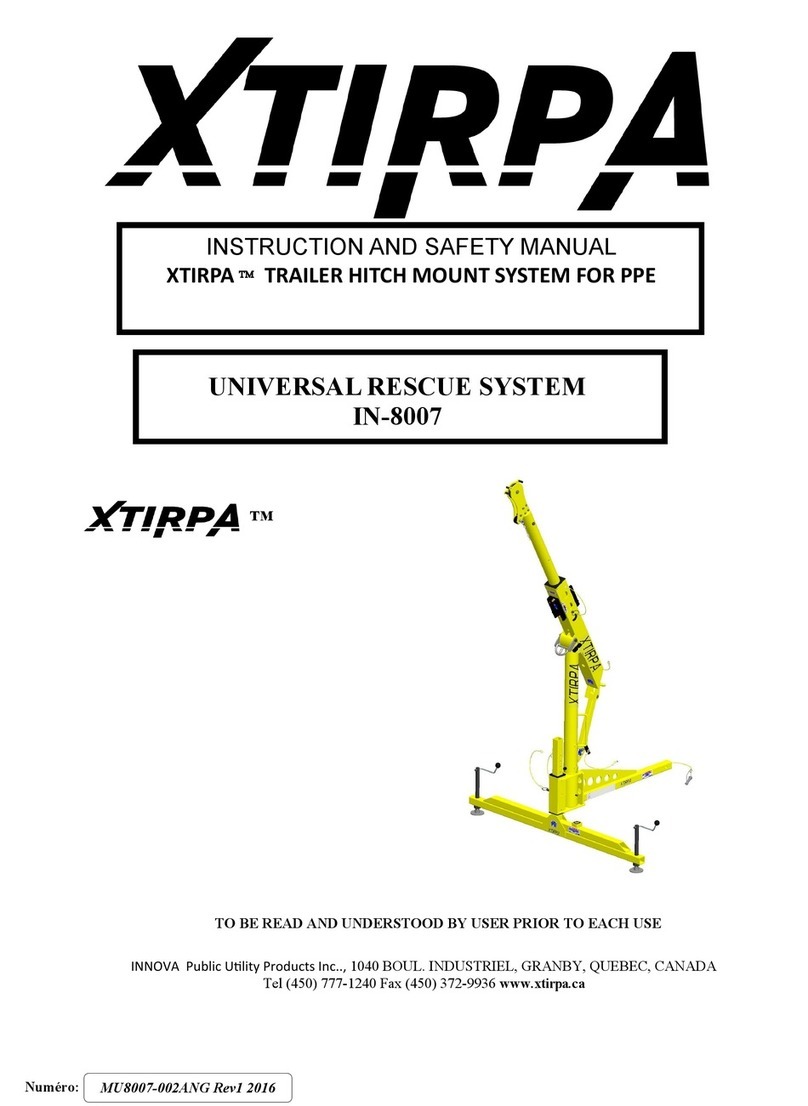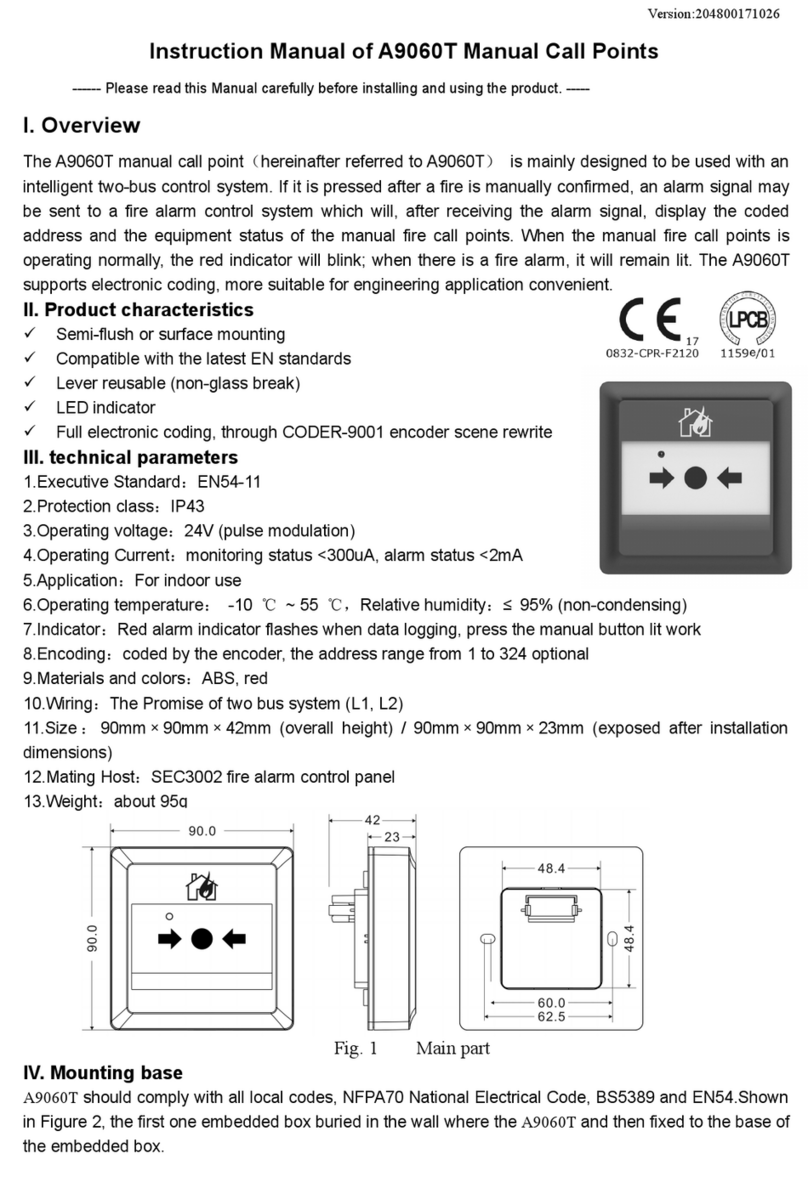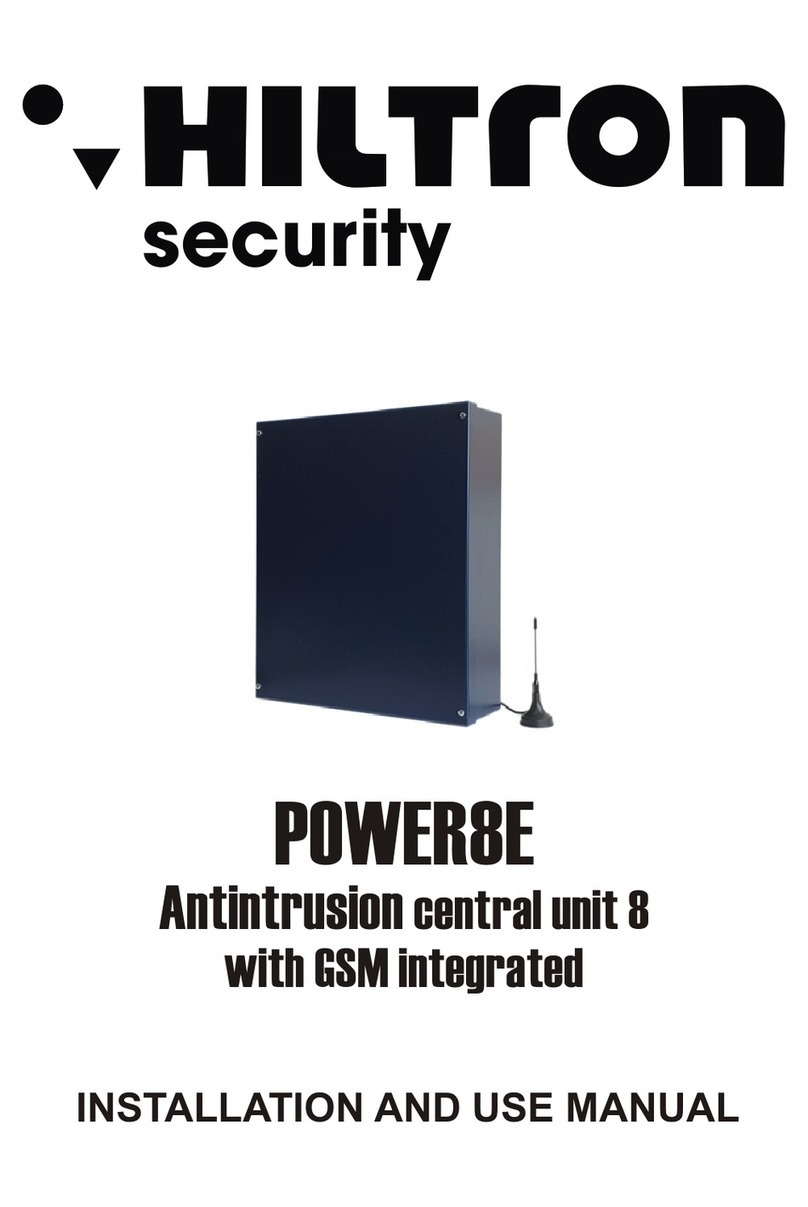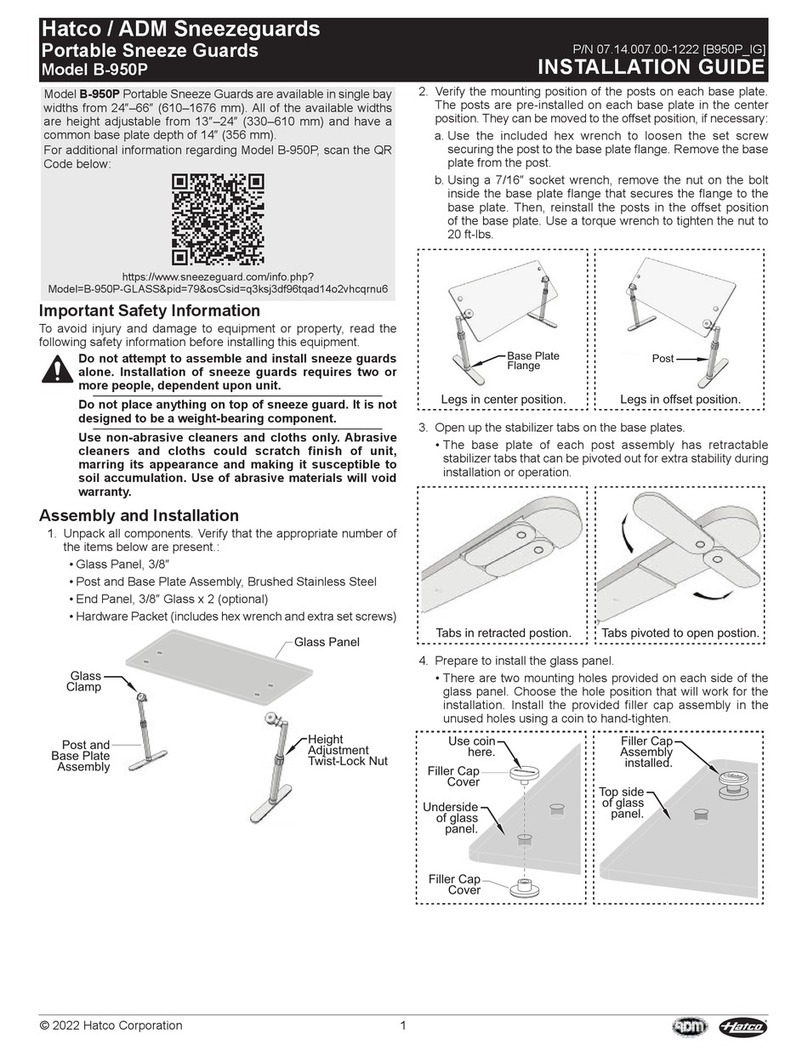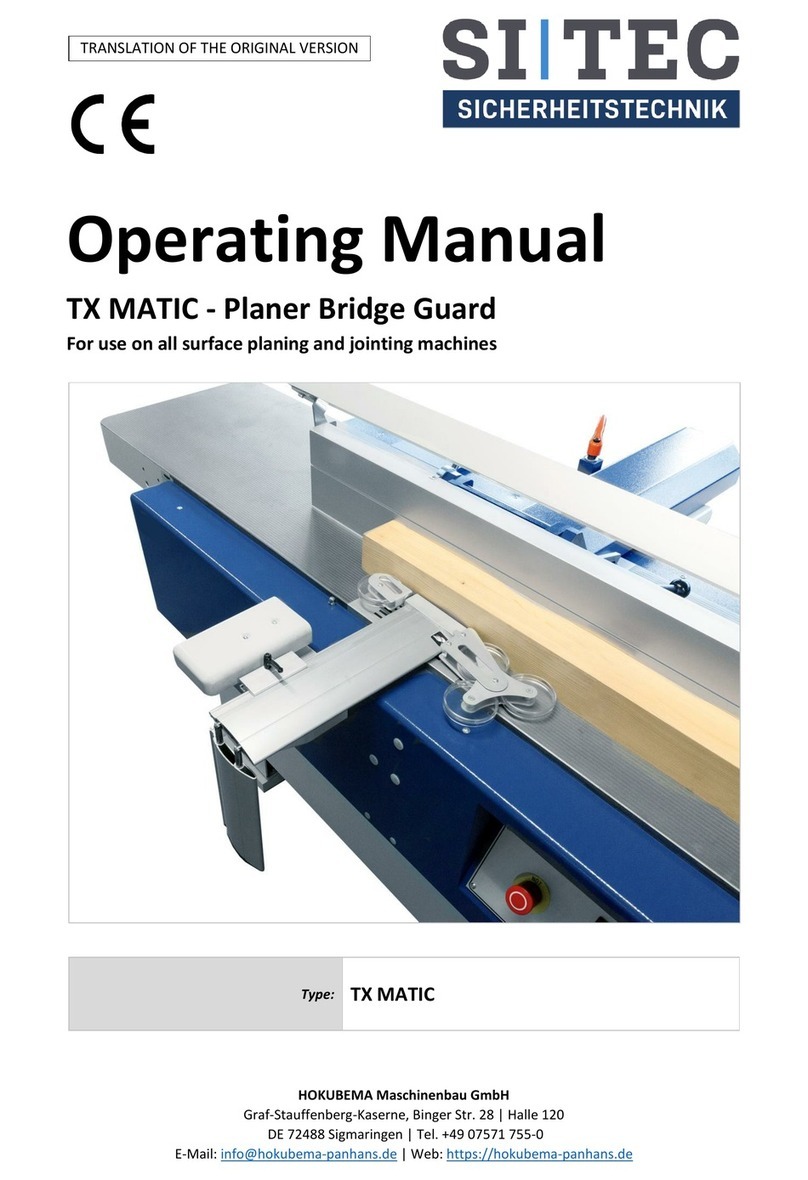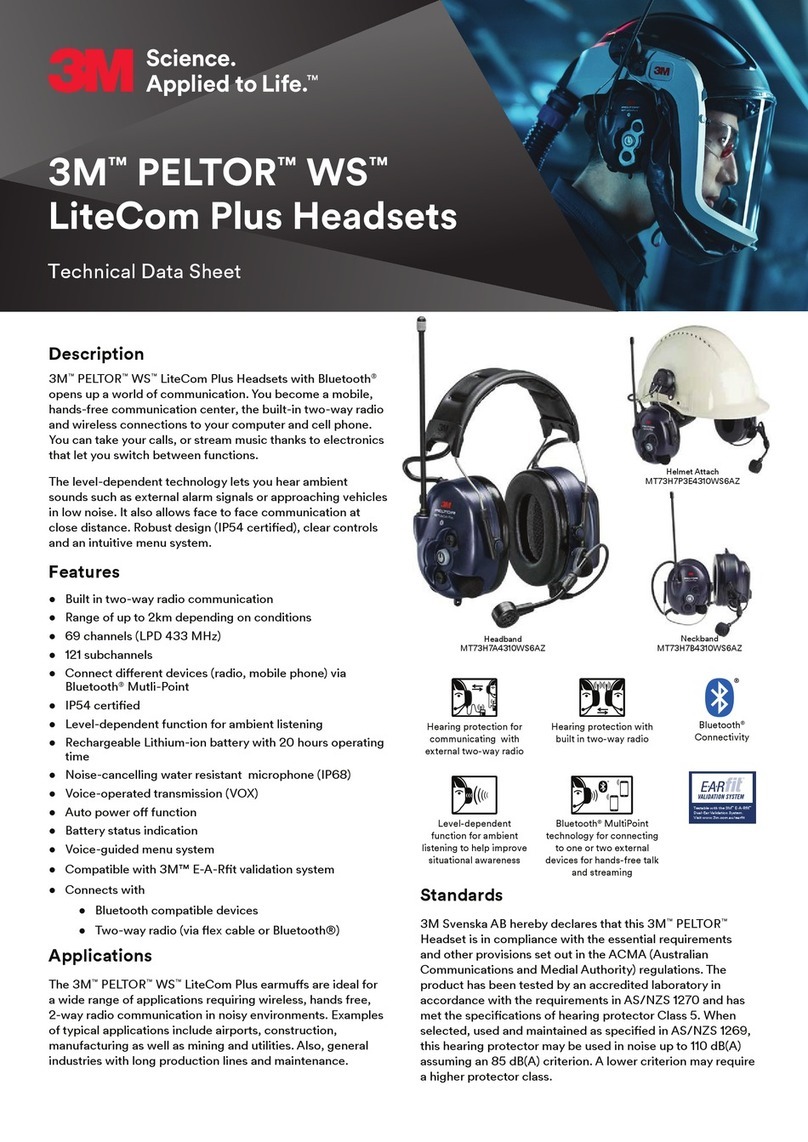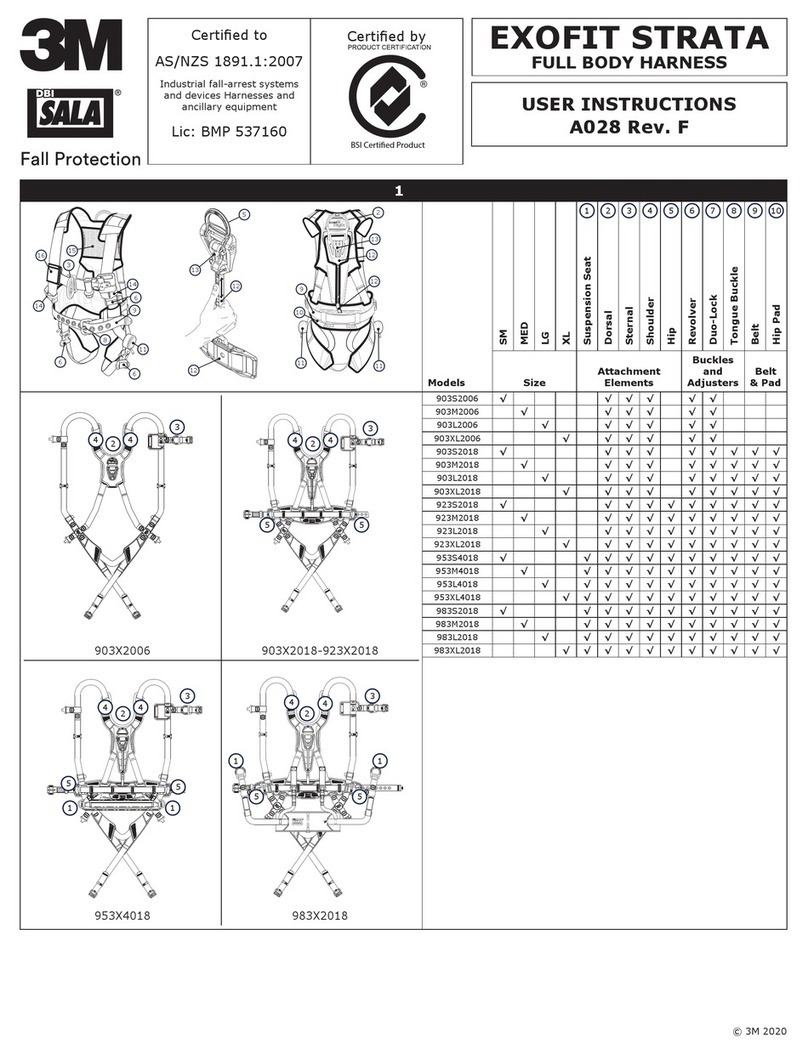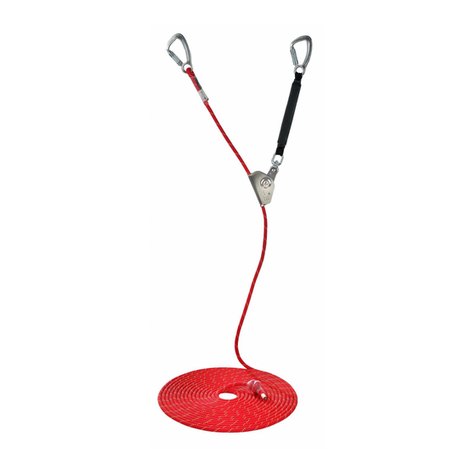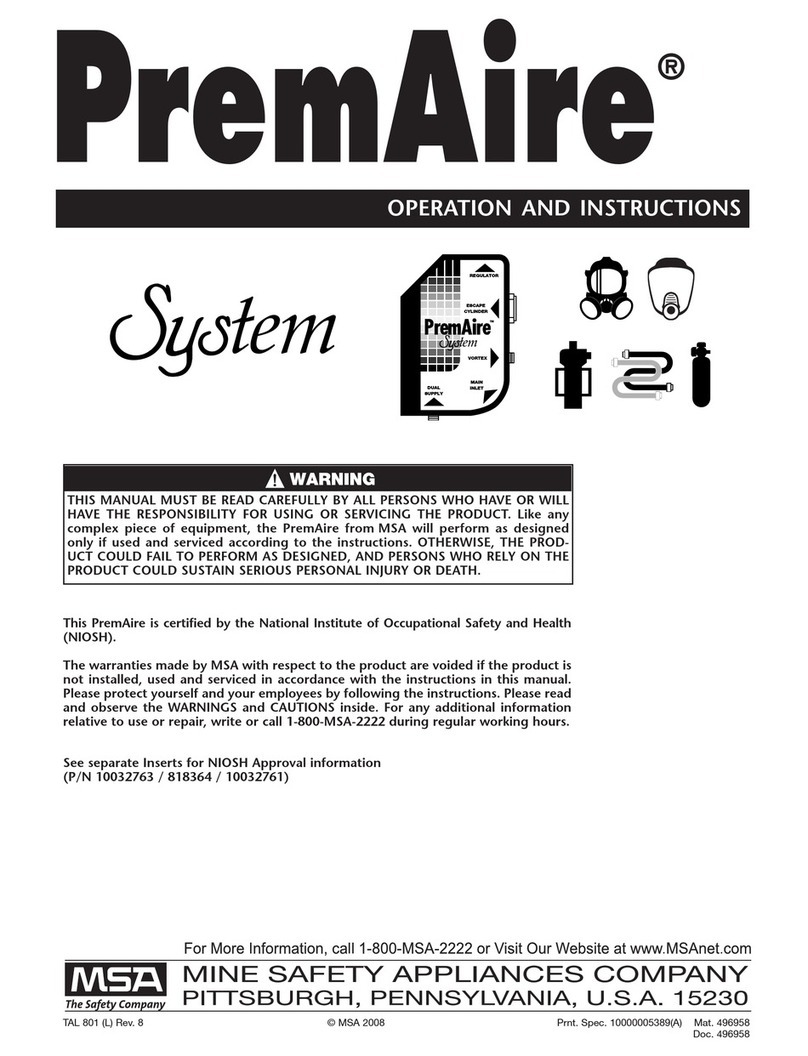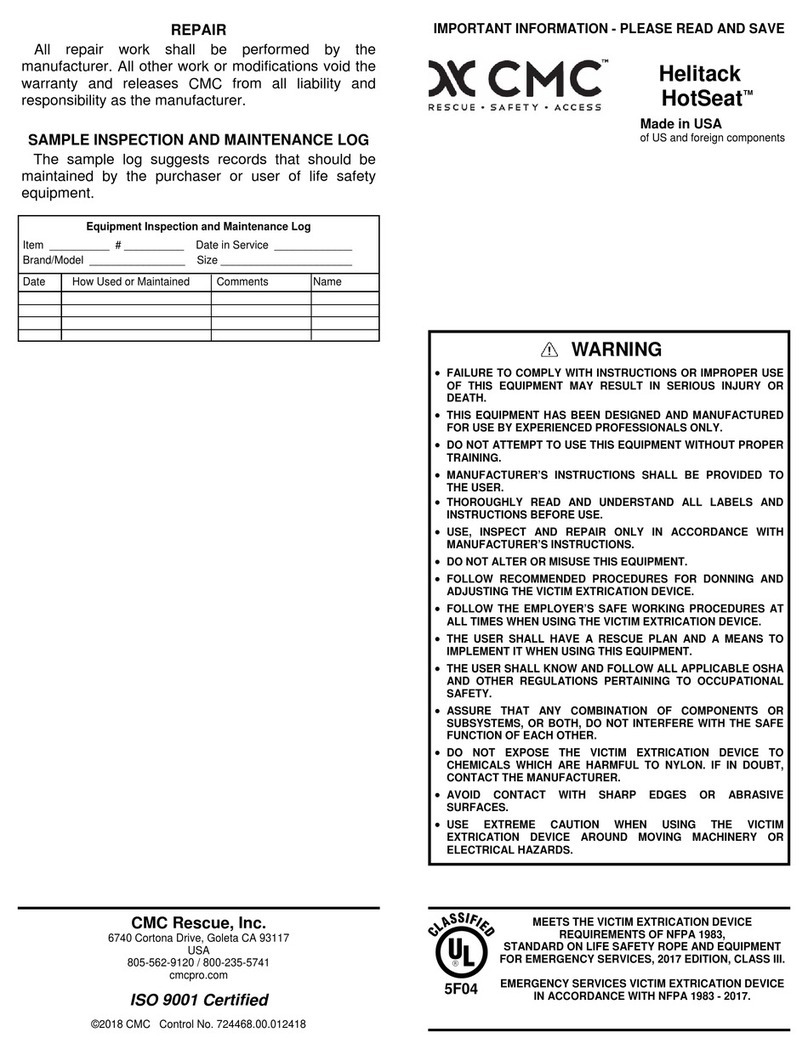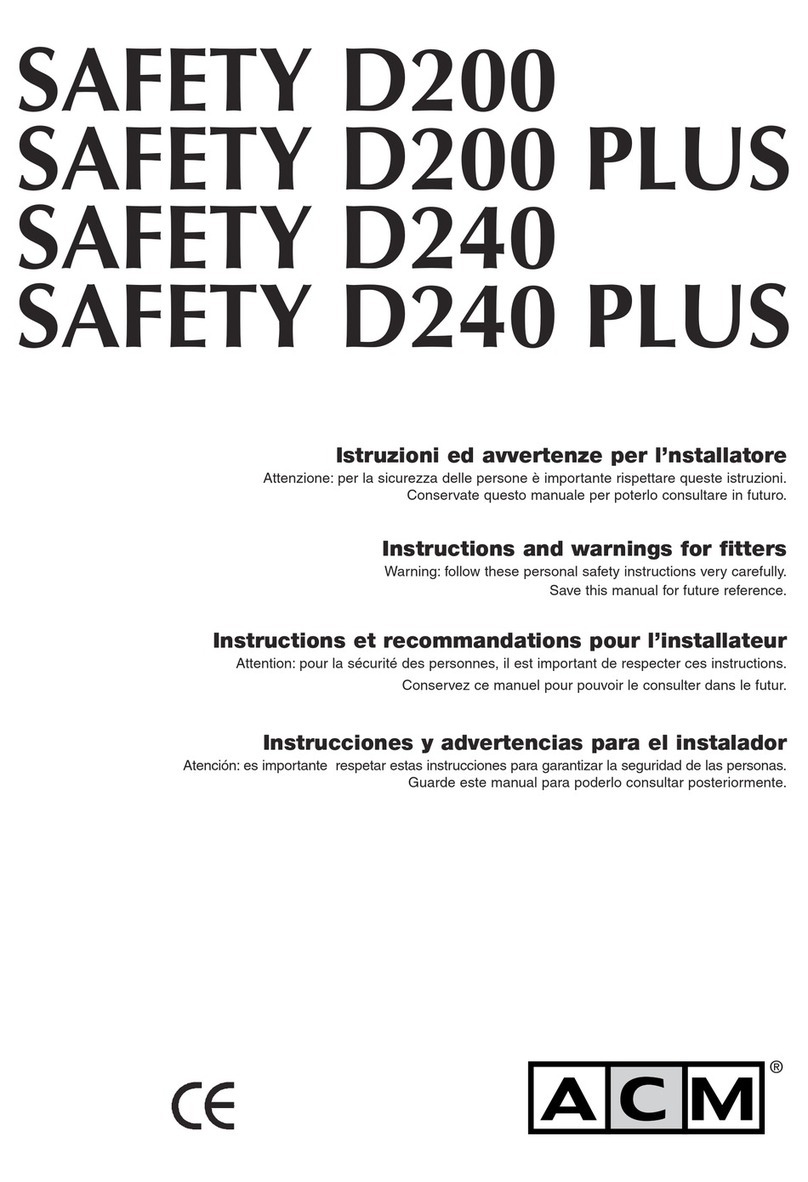
PL PT
OCHRONNIKI S¸¸
¸¸
¸UCHU Z RADIOODBIORNIKIEMPELTOR WORKSTYLE HTRXS
Efektywnie wytłumiajàce ochronniki słuchu z wmontowanym radioodbiornikiem FM-stereo.
Odbiór dzwi´ku stereo jest mo˝liwy równie˝ w Êrodowiskach o du˝ym nat´˝eniu hałasu. Radioodbiornik montowany w
ochronnikach słuchu HTRXS został zaprojektowany z myÊl´ o zwi´kszeniu bezpieczeƒstwa i motywacji u˝ytkownika
pracujàcego w warunkach o wysokim nat´˝eniu hałasu. Zestaw mo˝na równie˝ stosowaç np. podczas koszenia
trawnika lub gdy mamy ochot´ posłuchaç radia.
Ochronniki słuchu z radioodbiornikiem Peltor Workstyle przebadano i zatwierdzono do u˝ytku zgodnie z dyrektywà PPE
89/686/EEC i dyrektywà 89/336/EEC, co oznacza, ˝e spełniajà wymagania stawiane produktom otrzymujàcym znak
CE. Pełnà satysfakcj´ i zadowolenie z prawidłowo u˝ytkowanego produktu zapewni Ci dokładne zapoznanie si´ z
niniejszà instrukcjà obsługi.
(A) CO JEST CO?(A) CO JEST CO?
(A) CO JEST CO?(A) CO JEST CO?
(A) CO JEST CO?
1.1.
1.1.
1. Ekstra szeroki kabłàk wspierany na głowieEkstra szeroki kabłàk wspierany na głowie
Ekstra szeroki kabłàk wspierany na głowieEkstra szeroki kabłàk wspierany na głowie
Ekstra szeroki kabłàk wspierany na głowie z mi´kkà wyÊciółkà zapewnia wysoki komfort pracy.
2.2.
2.2.
2. Niskie podwieszenie dwupunktowe podsufitkiNiskie podwieszenie dwupunktowe podsufitki
Niskie podwieszenie dwupunktowe podsufitkiNiskie podwieszenie dwupunktowe podsufitki
Niskie podwieszenie dwupunktowe podsufitki i prosta regulacja wysokoÊci, bez wystajàcych cz´Êci.
3.3.
3.3.
3. Indywidualnie dopasowane spr´˝ynujàce przewody kabłàkaIndywidualnie dopasowane spr´˝ynujàce przewody kabłàka
Indywidualnie dopasowane spr´˝ynujàce przewody kabłàkaIndywidualnie dopasowane spr´˝ynujàce przewody kabłàka
Indywidualnie dopasowane spr´˝ynujàce przewody kabłàka ze stali spr´˝ynowej pozwalajà na równomierne rozło˝enie
nacisku i znacznie lepiej ni˝ kabłàki plastikowe zachowujà elastycznoÊç w szerokim zakresie temperatur.
4. Mi´kkie i szerokie poduszki wypełnione piankà/płynem4. Mi´kkie i szerokie poduszki wypełnione piankà/płynem
4. Mi´kkie i szerokie poduszki wypełnione piankà/płynem4. Mi´kkie i szerokie poduszki wypełnione piankà/płynem
4. Mi´kkie i szerokie poduszki wypełnione piankà/płynem nie uciskajà uszu, uszczelniajà efektywnie, zwi´kszajàc
komfort u˝ytkownika. Kanały wyrównujàce ciÊnienie regulujà ciÊnienie wywierane na b´benek ucha.
5.5.
5.5.
5. Pokr´tłoPokr´tło
Pokr´tłoPokr´tło
Pokr´tło umo˝liwiajàce: włàczanie i wyłàczanie, regulacj´ głoÊnoÊci i wybór kanału.
6.6.
6.6.
6. Krótka, gi´tka antenaKrótka, gi´tka antena
Krótka, gi´tka antenaKrótka, gi´tka antena
Krótka, gi´tka antena nisko zamocowana, zapewniajàca dobry odbiór.
7.7.
7.7.
7. Prosty i stabilny wybór kanałów.Prosty i stabilny wybór kanałów.
Prosty i stabilny wybór kanałów.Prosty i stabilny wybór kanałów.
Prosty i stabilny wybór kanałów. Zakres cz´stotliwoÊci 88–108 MHz.
8.8.
8.8.
8. Ograniczenie poziomu nat´˝enia dêwi´kuOgraniczenie poziomu nat´˝enia dêwi´ku
Ograniczenie poziomu nat´˝enia dêwi´kuOgraniczenie poziomu nat´˝enia dêwi´ku
Ograniczenie poziomu nat´˝enia dêwi´ku max 82 dB (A).
9.9.
9.9.
9. Pokrywa schowka bateriiPokrywa schowka baterii
Pokrywa schowka bateriiPokrywa schowka baterii
Pokrywa schowka baterii ułatwiajàca wymian´ baterii (w skład zestawu wchodzà dwie baterie alkaliczne 1,5 V
typu AA ). Nowe baterie zapewniajà 140-cio godzinnà eksploatacj´.
10.10.
10.10.
10. WejÊcie audioWejÊcie audio
WejÊcie audioWejÊcie audio
WejÊcie audio umo˝liwia podłàczenie radia przeznaczonego do komunikacji lub telefonu. UWAGA!UWAGA!
UWAGA!UWAGA!
UWAGA! Patrz max
dozwolony sygnał audio.
11.11.
11.11.
11. MikrofonyMikrofony
MikrofonyMikrofony
Mikrofony (pewne modele) umo˝liwiajà komunikacj´ w obu kierunkach w przypadku podłàczenia radia
przeznaczonego do komunikacji.
12.12.
12.12.
12. Przewód przyłàczeniowyPrzewód przyłàczeniowy
Przewód przyłàczeniowyPrzewód przyłàczeniowy
Przewód przyłàczeniowy (dotyczy jedynie modeli wyposa˝onych w mikrofon) słu˝àcy do podłàczenia radia
przeznaczonego do komunikacji lub telefonu w połàczeniu z adapterem marki Peltor.
INSTRUKCJA OBS¸UGIINSTRUKCJA OBS¸UGI
INSTRUKCJA OBS¸UGIINSTRUKCJA OBS¸UGI
INSTRUKCJA OBS¸UGI
Odkr´ç i zdejmij pokryw´ schowka baterii. Włó˝ dwie dołàczone baterie 1,5 V.
Sprawdê, czy bieguny + i - baterii sà właÊciwie umieszczone.
Włàcz kontrol´ głoÊnoÊci i za pomocà pokr´tła umieszczonego w prawym nauszniku wybierz ˝àdany kanał.
(B) Kabłàk wspierany na głowie:(B) Kabłàk wspierany na głowie:
(B) Kabłàk wspierany na głowie:(B) Kabłàk wspierany na głowie:
(B) Kabłàk wspierany na głowie: (B:1) Wyciàgnij nauszniki i załó˝ zestaw nagłowny na uszy tak, aby poduszki
uszczelniajàce całkowicie obejmowały uszy i szczelnie przylegały do głowy.
(B:2) Wyreguluj wysokoÊç nauszników jednoczeÊnie dociskajàc kabłàk do dołu w celu ustalenia najbardziej wygodnego
poło˝enia. (B:3) Kabłàk powinien znajdowaç si´ w pozycji pionowej.
(C) Gniazdo kasku:(C) Gniazdo kasku:
(C) Gniazdo kasku:(C) Gniazdo kasku:
(C) Gniazdo kasku: Zamontuj gniazdo kasku w zatrzasku umocowanym na kasku (patrz rys. C:1). Podczas pracy
przesuƒ nauszniki z poło˝enia wentylacyjnego do poło˝enia roboczego dociskajàc przewody kabłàka do oporu, czemu
towarzyszy charakterystyczny trzask. Sprawdê, czy w poło˝eniu roboczym nauszniki i przewód kabłàka nie znajdujà
si´ w pobli˝u podsufitki lub kraw´dzi kasku, co mogłoby osłabiç szczelnoÊç.
Uwaga!Uwaga!
Uwaga!Uwaga!
Uwaga! Nauszniki przeciwhałasowe mo˝na ustawiaç w 3 poło˝eniach: (C:2) poło˝enie robocze, (C:3) poło˝enie
wentylacyjne, (C:4) poło˝enie spoczynkowe.
Wa˝ne!Wa˝ne!
Wa˝ne!Wa˝ne!
Wa˝ne! Poduszki piankowe powinny szczelnie przylegaç do uszu. W tym celu nale˝y usunàç włosy zakrywajàce uszy.
Osoby noszàce okulary powinny zadbaç o to, aby gruboÊç uchwytów oprawek nie pogarszała zdolnoÊci uszczelniajàcych
poduszek.
WA˚NE INFORMACJE DLA U˚YTKOWNIKAWA˚NE INFORMACJE DLA U˚YTKOWNIKA
WA˚NE INFORMACJE DLA U˚YTKOWNIKAWA˚NE INFORMACJE DLA U˚YTKOWNIKA
WA˚NE INFORMACJE DLA U˚YTKOWNIKA
Ochronniki słuchu z radioodbiornikiem nale˝y zakładaç, regulowaç, czyÊciç i konserwowaç zgodnie z niniejszymiOchronniki słuchu z radioodbiornikiem nale˝y zakładaç, regulowaç, czyÊciç i konserwowaç zgodnie z niniejszymi
Ochronniki słuchu z radioodbiornikiem nale˝y zakładaç, regulowaç, czyÊciç i konserwowaç zgodnie z niniejszymiOchronniki słuchu z radioodbiornikiem nale˝y zakładaç, regulowaç, czyÊciç i konserwowaç zgodnie z niniejszymi
Ochronniki słuchu z radioodbiornikiem nale˝y zakładaç, regulowaç, czyÊciç i konserwowaç zgodnie z niniejszymi
instrukcjami.instrukcjami.
instrukcjami.instrukcjami.
instrukcjami.
-Ochronniki słuchu z radiodbiornikiem nale˝y nieprzerwanie stosowaç podczas prac wykonywannych w Êrodowiskach
o du˝ym nat´˝eniu hałasu.
-Ochronniki słuchu z radiodbiornikiem nale˝y regularnie czyÊciç/dezynfekowaç w letniej wodzie z mydłem, chroniàcchroniàc
chroniàcchroniàc
chroniàc
je przed całkowitym zanurzeniem w wodzie.je przed całkowitym zanurzeniem w wodzie.
je przed całkowitym zanurzeniem w wodzie.je przed całkowitym zanurzeniem w wodzie.
je przed całkowitym zanurzeniem w wodzie.
-Ochronników słuchu z radiodbiornikiem nie nale˝y przechowywaç w temp. powy˝ej +55°C np, na oknie lub za
przednià szybà samochodu.
-U˝ytkowanie i starzenie si´ materiałów powodujà pogorszenie si´ stanu ochronników słuchu, a w szczególnoÊci
poduszek piankowych. Kontrole majàce na celu wykrycie p´kni´ç i osłabienia zdolnoÊci uszczelniajàcych nale˝y
przeprowadzaç regularnie.
-Wyst´powanie zakłóceƒ to znak, ˝e nadeszła pora wymiany baterii.
-Bł´dne umieszczenie baterii mo˝e spowodowaç uszkodzenie funkcji elektronicznych. Nigdy nie wymieniaj baterii
gdy funkcje te sà włàczone.
Przed przystàpieniem do u˝ytkowania nale˝y sprawdziç, czy baterie sà poprawnie umieszczone.
-Produkt, a w szczególnoÊci poduszki piankowe, mogà pod wpływem kontaktu z pewnymi substancjami chemicznymi
ulec uszkodzeniu. Szczegółowych informacji na ten temat udziela producent.
-Na czas składowania nale˝y usunàç baterie ze schowka!
UWAGA!UWAGA!
UWAGA!UWAGA!
UWAGA! Nieprzestrrzeganie w/w instrukcji prowadzi do znacznego osłabienia funkcjonalnoÊci ochronników i spadku
wytłumienia.
WARTOÂCI WYT¸UMIENIAWARTOÂCI WYT¸UMIENIA
WARTOÂCI WYT¸UMIENIAWARTOÂCI WYT¸UMIENIA
WARTOÂCI WYT¸UMIENIA
WartoÊci wytłumienia i poziom nat´˝enia dêwi´ku ochronników słuchu z radioodbiornikiem Peltor Workstyle przebadano
i zatwierdzono do u˝ytku zgodnie z dyrektywà PPE 89/686/EEC i ust´pami normy Standardu Europejskiego EN 352-
1:1993/prEN 352-3. Obliczony poziom nat´˝enia dêwi´ku - muzyki (wa˝ony wg krzywej A) w słuchawkach nie
powinien przekraczaç 80 dB (A), zgodnie z wymogami dyrektywy PPE.
(D:1) Model HTRXS7A(D:1) Model HTRXS7A
(D:1) Model HTRXS7A(D:1) Model HTRXS7A
(D:1) Model HTRXS7A z kabłàkiem wspieranym na głowie. Ci´˝ar: 340 g.
Model HTRXS7A-01Model HTRXS7A-01
Model HTRXS7A-01Model HTRXS7A-01
Model HTRXS7A-01 jak wy˝ej lecz z wejÊciem audio.
Model HTRXS7A-07Model HTRXS7A-07
Model HTRXS7A-07Model HTRXS7A-07
Model HTRXS7A-07 jak wy˝ej lecz z wejÊciem audio, mikrofonem i przewodem przyłàczeniowym. Ci´˝ar: 370 g.
(D:2) Model HTRXS7P3E(D:2) Model HTRXS7P3E
(D:2) Model HTRXS7P3E(D:2) Model HTRXS7P3E
(D:2) Model HTRXS7P3E z kabłàkiem wspieranym na głowie. Ci´˝ar: 370 g.
Model HTRXS7P3E-01Model HTRXS7P3E-01
Model HTRXS7P3E-01Model HTRXS7P3E-01
Model HTRXS7P3E-01 jak wy˝ej lecz z wejÊciem audio.
Model HTRXS7P3E-07Model HTRXS7P3E-07
Model HTRXS7P3E-07Model HTRXS7P3E-07
Model HTRXS7P3E-07 jak wy˝ej lecz z wejÊciem audio, mikrofonem i przewodem przyłàczeniowym.
Ci´˝ar: 400 g. Âwiadectwo próby wystawione przez FIOH, Laajaniityntie 1, FIN-01621 Vantaa. ID 0403.
Ochronniki słuchu z radioodbiornikiem Peltor Workstyle spełniajà wymogi zgodnie z dyrektywà EMC.
(E) Poziom nat´˝enia sygnału wejÊciowego/czas eksploatacji:(E) Poziom nat´˝enia sygnału wejÊciowego/czas eksploatacji:
(E) Poziom nat´˝enia sygnału wejÊciowego/czas eksploatacji:(E) Poziom nat´˝enia sygnału wejÊciowego/czas eksploatacji:
(E) Poziom nat´˝enia sygnału wejÊciowego/czas eksploatacji:
Maksymalny dopuszczalny sygnał audio w stosunku do czasu eksploatacji W celu unikni´cia szkodliwego poziomu
nat´˝enia dêwi´ku w słuchawkach nie wolno przekroczyç podanych wartoÊci sygnałów wejÊciowych (Êredni poziom
nat´˝enia mowy).
CZ¢ÂCI ZAMIENNE/WYPOSA˚ENIE DODATKOWECZ¢ÂCI ZAMIENNE/WYPOSA˚ENIE DODATKOWE
CZ¢ÂCI ZAMIENNE/WYPOSA˚ENIE DODATKOWECZ¢ÂCI ZAMIENNE/WYPOSA˚ENIE DODATKOWE
CZ¢ÂCI ZAMIENNE/WYPOSA˚ENIE DODATKOWE
ZESTAW HIGIENICZNY – HY73ZESTAW HIGIENICZNY – HY73
ZESTAW HIGIENICZNY – HY73ZESTAW HIGIENICZNY – HY73
ZESTAW HIGIENICZNY – HY73
¸atwowymienialny zestaw higieniczny składajàcy si´ z 2 poduszek wytłumiajàcych i poduszek piankowych z funkcjà
zatrzaskowà. W celu zapewnienia stałego poziomu wytłumienia, higieny i komfortu zestaw nale˝y wymieniaç co najmniej
dwa razy do roku.
Clean – jednorazowa nakładka zabezpieczajàca – HY100Clean – jednorazowa nakładka zabezpieczajàca – HY100
Clean – jednorazowa nakładka zabezpieczajàca – HY100Clean – jednorazowa nakładka zabezpieczajàca – HY100
Clean – jednorazowa nakładka zabezpieczajàca – HY100
Jednorazowa nakładka zabezpieczajàca Clean łatwo mocowana na poduszkach piankowych. Opakowanie zawiera
100 par jednorazowych nakładek ochronnych.
Przewód przyłàczeniowy wejÊcia audioPrzewód przyłàczeniowy wejÊcia audio
Przewód przyłàczeniowy wejÊcia audioPrzewód przyłàczeniowy wejÊcia audio
Przewód przyłàczeniowy wejÊcia audio
FL6H - 3,5 mm zatyczka mono
FL6M - 2,5 mm zatyczka mono
FL6N - 3,5 mm zatyczka stereo do radia micman do komunikacji
(F) Czas u˝ytkowania 100% – jedyne pewne zabezpieczenie przed uszkodzeniem s›uchu.(F) Czas u˝ytkowania 100% – jedyne pewne zabezpieczenie przed uszkodzeniem s›uchu.
(F) Czas u˝ytkowania 100% – jedyne pewne zabezpieczenie przed uszkodzeniem s›uchu.(F) Czas u˝ytkowania 100% – jedyne pewne zabezpieczenie przed uszkodzeniem s›uchu.
(F) Czas u˝ytkowania 100% – jedyne pewne zabezpieczenie przed uszkodzeniem s›uchu.
(I:1) Czas u˝ytkowania 100% Daje spodziewanà ochron´.
(I:2) Czas u˝ytkowania
99% 5 minut zaniedbania dziennie znacznie obni˝a efektywnoÊç ochronników s›uchu.
(I:3) Czas u˝ytkowania 90% Nie nale˝y spodziewaç si´ efektywnej ochrony.
•Codzienne przebywanie w Êrodowiskach o nat´˝eniu ha›asu przekraczajàcym 85 dB (A) wymaga ochrony s›uchu.
•Najbardziej nara˝one na dzia›anie ha›asu sà komórki ucha Êrodkowego. Uszkodzenie ich powoduje nieodwracalne
sta›e zmiany.
•Wygodne dla u˝ytkownika ochronniki s›uchu dopasowane do nat´˝enia ha›asu w Êrodowisku pracy gwarantujà
100%-owy czas u˝ytkowania, a tym samym chronià przed nieodwracalnymi uszkodzeniami s›uchu.
RÁDIO DE PROTECÇÃO AUDITIVA PELTOR WORKSTYLE HTRXS
é uma protecção auditiva de forte atenuação com receptor de rádio FM-estéreo de alta sensibilidade incorporado.
A reprodução em estéreo do som isento de interferências, funciona optimamente mesmo em meios ruidosos.
O rádio de protecção auditiva HTRXS foi especialmente projectado para melhorar a segurança e a motivação
quando você trabalha em meios ruidosos. Também pode ser utilizado quando você, por ex. corta a relva ou
em qualquer outro caso em que queira ouvir rádio sem interferências. O Rádio de Protecção Auditiva Peltor
Worstyle foi testado e aprovado em concordância com as directivas PPE 89/686/ EEC e EMC 89/336/ EEC,
implicando que os requisitos para marcação CE foram cumpridos. Para ficar completamente satisfeito com o
produto, é importante que leia estas instruções de utilização na sua totalidade.
(A) O QUE É?
1. Arco de cabeça extralargo com estofado macio para máxima comodidade durante o dia inteiro de trabalho.
2. Suspensão baixa de dois pontos e ajustamento fácil da altura sem peças protuberantes.
3. Arcos de arame com elasticidade individual em aço de mola inoxidável, proporcionando uma distribuição
uniforme da pressão em redor das orelhas. Mantêm a elasticidade própria melhor do que arcos plásticos
normais, dentro de uma ampla área de temperatura.
4. Anéis de vedação macios e amplos, cheios de espuma/líquido com canais compensadores de pressão
integrados, oferecem baixa pressão, vedação eficaz e comodidade individual.
5. Comandos protectores para ligar/desligar, volume e sintonia das estações.
6. Antena supercurta flexível com fixação baixa e alta sensibilidade de recepção.
7. Sintonia de estações emissoras, simples e estável. Gama de frequências, 88–108 MHz.
8. Limitação do nível sonoro, máx. 82 dB(A) de nível sonoro equivalente.
9. Tampa daspilhas, para fácil substituição das pilhas (duas pilhas alcalinas de 1,5 V, tipo AA, incluídas).140
horas de funcionamento com pilhas novas.
10. Entrada de audiofrequência (certos modelos) possibilita a ligação de, por ex. rádiotelefone para escuta.
NOTA: Sinal máximo de audiofrequência permitido
11. Microfone (em certos modelos) possibilita a comunicação de duas vias com rádio-telefone.
12. Cabo de ligação (apenas nos modelos com microfone) para ligar ao rádio-telefone juntamente com
sistema de adaptação Peltor.
INSTRUÇÕES DE UTILIZAÇÃO
Desaparafuse e remova a tampa das pilhas. Coloque as duas pilhas de 1,5 V incluídas. Verifique se os pólos
+ e - das pilhas estão virados para o lado certo.
Ligue no botão do volume e sintonize a estação desejada no botão selector de estações no invólucro da
direita.
(B) Arco para a cabeça: (B:1) Puxar os auscultadores para fora. Pôr os auscultadores sobre as orelhas de
forma aos anéis de vedação vedarem bem contra a cabeça. (B:2) Ajustar a altura dos auscultadores movendo
os auscultadores para cima ou para baixo e mantendo simultaneamente o arco contra a cabeça até obter
uma adaptação confortável e estanque. (B:3) O arco deverá ficar vertical sobre a cabeça.
(C) Suporte de capacete: Montar o suporte de capacete nas ranhuras de montagem até soar estalido de
encaixe (ver fig. C:1). Ao utilizar, devem os arcos de arame ser premidos para dentro até soarem estalidos em
ambos os lados, ao passar da posição de ventilação para posição de trabalho. Certifique-se de que, na
posição de trabalho, os auscultadores e arcos de arame não estão de encontro ao arnês ou beirada do
capacete de protecção provocando fuga.
NOTA: Os auscultadores podem ser postos em três posições: (C:2) de trabalho, (C:3) de ventilação e (C:4)
de “estacionamento”.Importante! Para obter o máximo efeito protector, afastar o cabelo em redor das orelhas
de forma aos anéis de vedação vedarem bem contra a cabeça. Hastes de óculos deverão ser tão finas quanto
possível e estar bem encostadas à cabeça.
INFORMAÇÃO IMPORTANTE PARA O UTILIZADOR
O rádio de protecção auditiva deve ser posto, ajustado, limpo e mantido de acordo com estas instruções
de utilização.
-Quando em meios ruidosos, utilize o rádio de protecção auditiva 100% do tempo para obter o máximo
efeito protector.
-Limpe regularmente o exterior do rádio de protecção auditiva com água morna e sabão. Não mergulhar
em água.
-Não guarde o rádio de protecção auditiva a temperaturas superiores a +55ºC, por ex. atrás dum pára-
brisas ou duma janela.
-Este artigo pode ser afectado por certas substâncias químicas. Para mais informação, contactar o fabricante.
-Quando as interferências aumentarem e o som se tornar demasiado fraco, estará na altura de mudar as
pilhas.
-Apolaridade incorrecta das pilhas pode danificar os circuitos electrónicos. Nunca mudar pilhas com o
circuito electrónico ligado. Verificar se as pilhas estão correctamente montadas antes de utilizar o aparelho.
-Orádio de protecção auditiva e especialmente os anéis de vedação podem deteriorar-se com a passagem
do tempo, devendo ser inspeccionados a intervalos regulares, de maneira a não haver fendas ou fugas
sonoras.
-Não armazenar com as pilhas montadas!
NOTA: Se estas recomendações não forem seguidas podem a atenuação sonora e a função ser afectadas.
VALORES DE ATENUAÇÃO
Os valores de atenuação do Rádio de Protecção Auditiva Peltor Workstyle foram testados e aprovados em
concordância com a directiva PPE 89/686 EEC e partes aplicáveis da Norma Europeia NE 352-1:1993/prNE
352-3. Nível sonoro de auscultador de música medido para máx. 80 dB(A) nível sonoro equivalente, de
acordo com os requisitos na directiva PPE.
(D:1) Modelo HTRXS7A com arco craniano. Peso: 340 g. Modelo HTRXS7A-01, como acima mas com
entrada de audiofrequência. Modelo HTRXS7A-07, como acima mas com entrada de audiofrequência, microfone
e cabo de ligação. Peso: 370 g. (D:2) Modelo HTRXS7P3E com suportes para capacete. Peso: 370 g.
Modelo HTRXS7P3E-01, como acima mas com entrada de audiofrequência. Modelo HTRXS7P3E-07, como
acima mas com entrada de audiofrequência, microfone e cabo de ligação. Peso: 400 g. Certificado emitido
por FIOH, Laajaniityntie 1, FIN-01621 Vantaa. IC#0403. O Rádio de Protecção Auditiva Peltor Workstyle
cumpre os requisitos segundo a directiva EMC.
(E) Nível de sinal de entrada/tempo de utilização.
Máximo sinal de audiofrequência permitido em relação ao tempo de utilização. Para o nível sonoro de
auscultador não atingir um nível nocivo à audição, não deverão os sinais de entrada indicados ser ultra-
passados. (Nível médio do sinal de fala.)
PEÇAS SOBRESSELENTES/ACESSÓRIOS
Conjunto higiénico – HY73
Conjunto higiénico de fácil substituição, composto de duas almofadas atenuadoras com anéis de vedação
com função de encaixe rápido. Mudar pelo menos duas vezes ao ano para garantir um nível constante de
atenuação, higiene e comodidade.
Protectores descartáveis Clean – HY100
Protector descartável de fácil montagem nos anéis de vedação. Embalagem com 100 pares de protectores
descartáveis.
Cabo de ligação para a entrada de audiofrequência
FL6H: ficha mono de 3,5 mm
FL6M: ficha mono de 2,5 mm
FL6N: ficha estéreo de 3,5 mm para radiotelefone micman
(F) 100% DE TEMPO DE USO – A ÚNICA PROTECÇÃO SEGURA CONTRA LESÕES AUDITIVAS.
(I:1) Tempo de uso 100%. Oferece a protecção prevista.
(I:2) Tempo de uso 99%. 5 minutos de descuido diário reduzem consideravel mente o efeito protector.
(I:3) Tempo de uso 90%. Já não se pode esperar uma protecção segura.
•Aexposição diária a sons com mais que 85 dB de nível de som comparado-A, implica que deve proteger
a sua audição.
•
As células auditivas no fundo do ouvido são danificadas e já não cicatrizam. A lesão torna-se permanente.
•Uma protecção cómoda, adaptada ao nível de ruído a que se é exposto é a melhor garantia de que os
protectores auditivos serão usados 100% do tempo, protegendo assim contra lesões permanentes.

